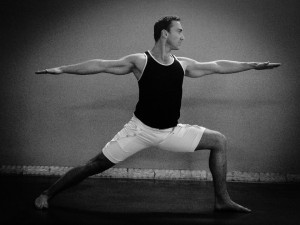
HOW TO MASTER YOUR WARRIOR II IN 6 EASY STEPS by Alessandro Lizza
HOW TO MASTER YOUR WARRIOR II IN 6 EASY STEPS
Warrior II or Virabhadrasana II is a very important asana included in almost every yoga practice and it is often performed more than once in the same session.
Legend has it that a powerful hero, Virabhadra, was created and instructed to lead his army against the God-Sage Daksa, guilty about celebrating a sacrifice without inviting his daughter Sati and her husband Shiva, the Chief of the Gods. Accomplishing to interrupt and destroy the infamous rite, the warrior was at last able to bring justice again.
The implication with this tale reminds us how important it is to perform this asana with the right attitude and a hint of pride and solemnity about it.
The movements create lengthening in the muscles of chest, arms, front and back leg while there is a widening in the chest area and pelvis with the development of confidence and stability for the body and ultimately for the mind.
Let’s see that in greater detail:
1-Starting from mountain pose (standing with feet hip-distance apart) , take a big inhalation and spread your legs apart sideways about 4 to 4 1/2 feet . At the same time, lift the arms bringing them aligned with the shoulders, keeping the blades wide and palms down.
2- Turn the foot ( the one going to the front ) sideways 90 degrees, while turning the other one (about 45 degrees) in the same direction. The heels of the feet are aligned and the thighs are both firm, but the one on the leg extending behind, is slightly turned outward so to have the center of the kneecap in line with the center of the ankle below.
Always remember the back leg is the one providing most support alleviating the strain from the front one (especially in the knee area). For this purpose, make sure the back foot is completely flat on the mat/floor.
3- Exhale and bend your front knee over (but not beyond) the ankle so to have the shin perpendicular to the floor. Ideally, the front thigh should be parallel to the floor and form a right angle with the calf. Such position helps minimizing again any possible harm in the front knee.
A common mistake for this knee is also to have a tendency to drift inward. This is best avoided being aware of it and counteracting it with an additional engagement of the buttock muscles of the leg involved, in order to abduct the inside of the knee toward the little-toe side of the foot. It is important to maintain front hip, thigh and lower leg in alignment at all times to keep the knee in the right place.
4-Stretch the arms sideways and parallel to the floor imagining you are being pulled from opposite ends . Don’t lean the torso but keep it perpendicular (strengthen the arms and open the chest more) so that the sides are equally long and the shoulders are directly over the pelvis. Press the tailbone slightly toward the pubis. Turn the head in the direction of the front leg gazing at the front hand and its fingers.
5- Stay as long as required, usually starting with 20 seconds and building it up to 4 long breaths or more. If the muscles of the thigh become fatigued, partially release the front knee for a few seconds moving up a bit before returning to full pose.
6- Inhale and come up. Reverse the feet and repeat on the other side to keep the work symmetrical and balanced.
Warrior II shouldn’t be practiced with stomach disorders and high blood pressure and, in case of any neck problem, instead of turning the head to look over the front hand, it’s more advisable to look straight ahead with both sides of the neck lengthened evenly.
Several are the benefits coming with this posture besides strengthening all the muscles involved especially in the legs and arms.
There is a stimulation of the abdominal organs and an increase on stamina. It can be therapeutic for carpal tunnel syndrome, flat feet, infertility, osteoporosis, and sciatica while relieving backaches and cramps.
Learning to master the standing asanas and this particular one, provides a great tool to prepare the practitioner for the advanced poses in forward bending also creating, at the same time, an attitude for a body able to convey concentration, stability and readiness. Enjoy it!
Namastè
